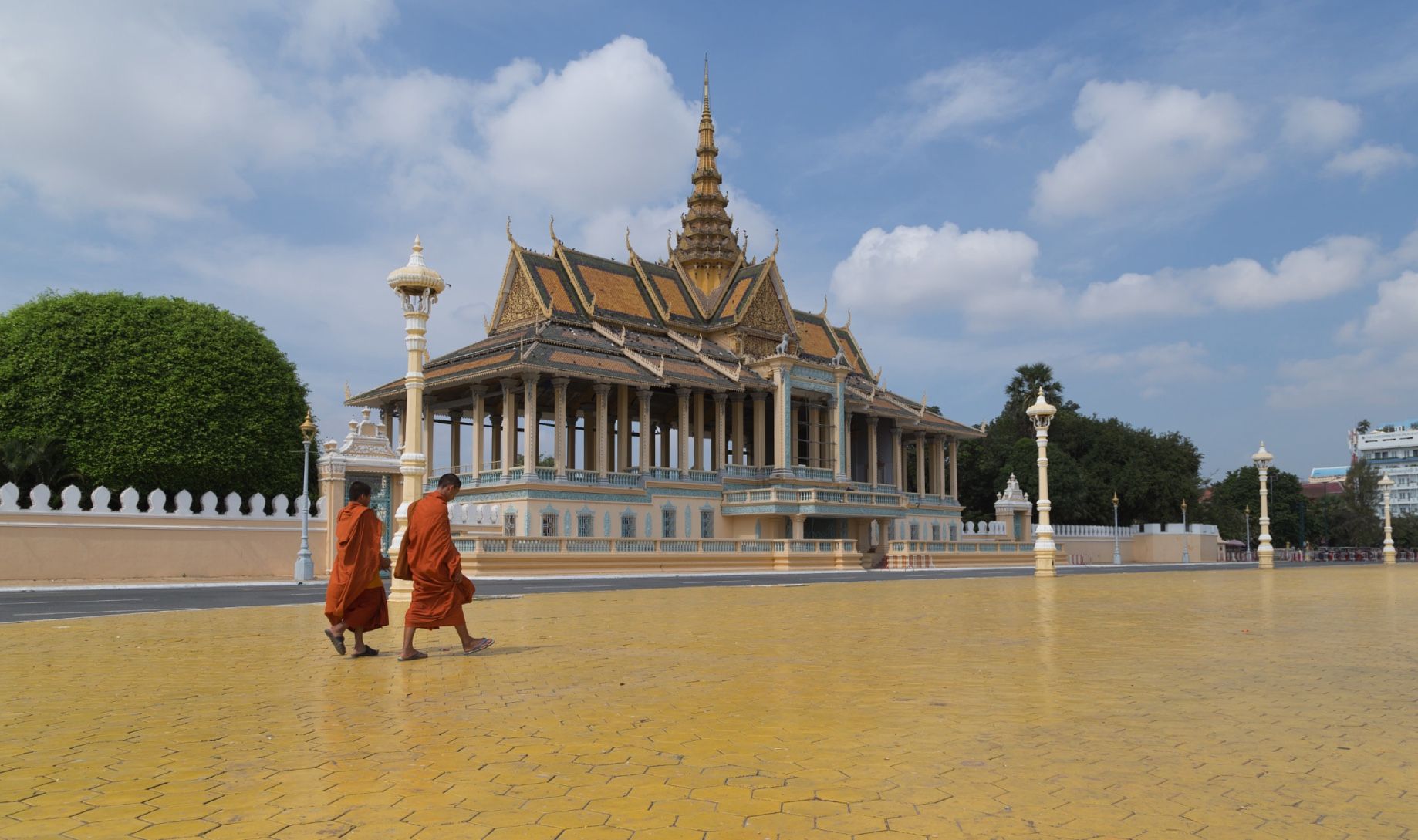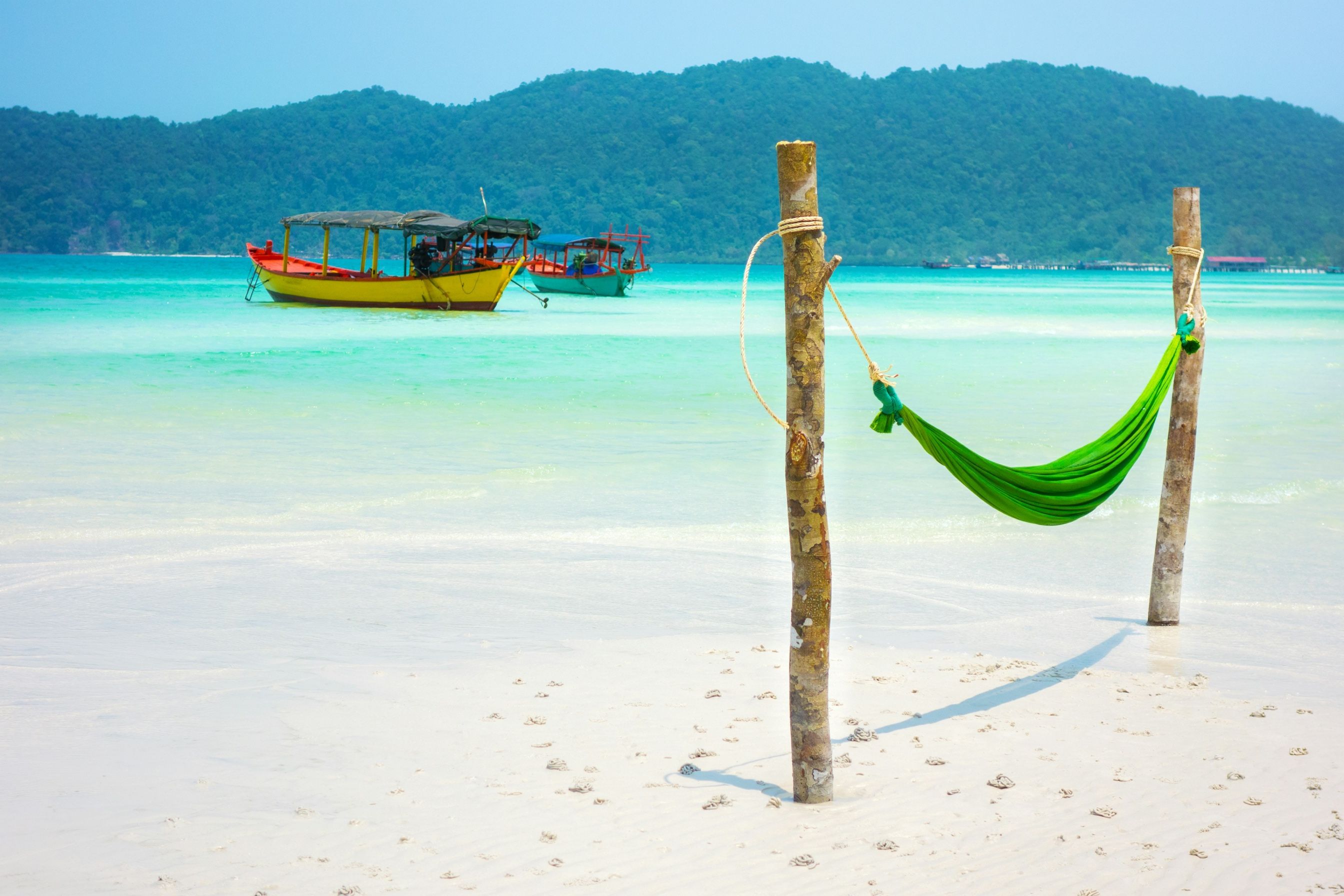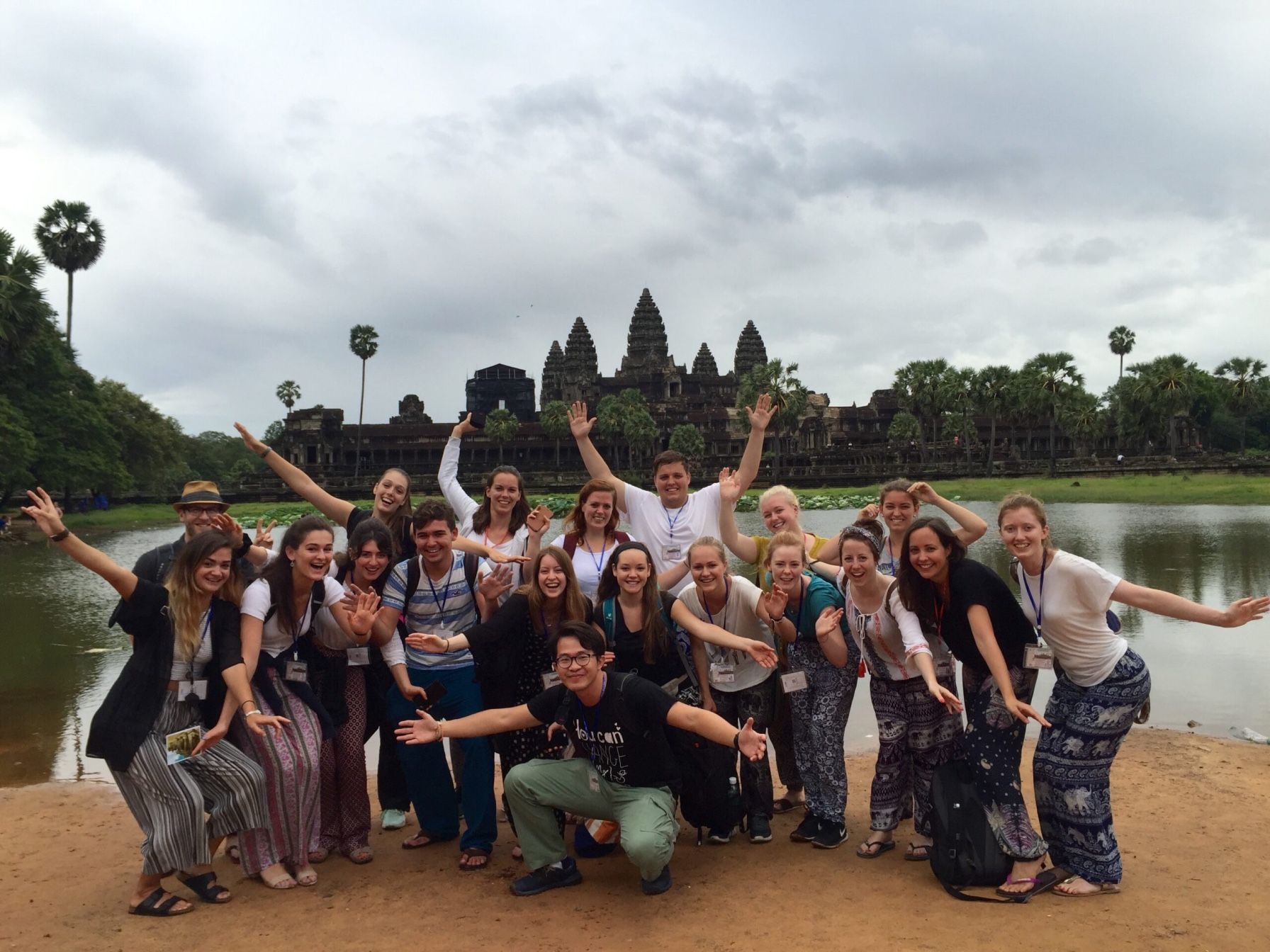Cambodia Travel Guide & Advice: How to plan your first visit in 2025
This is a full Cambodia travel guide help you plan your trip, save money, and ensure you have the best time for visiting the country, whether a one week, 2 weeks and or three weeks across the Cambodia.
One of the most breathtaking sights you can experience is to see the temples of Angkor Wat at sunset and although many never go far beyond this spectacular complex during their trip in Cambodia, more and more travelers are beginning to realise that Cambodia has much more to offer than the famous Temples of Angkor.
There are a great variety of things to do, to see and activities to expect while in Cambodia.
The country is blessed with undeveloped golden beaches, unspoilt forests and beautiful old colonial cities like Phnom Penh, Battambang, Kampot and Kep, all of which have a very relaxing atmosphere.
It is also the gentle, polite and charming personality of the Khmer people which makes Cambodia such a memorable destination and after decades of upheaval and isolation, Cambodia is emerging as a new and exciting tourist destination. Check our our top example Cambodia luxury Tours
Expert Advices to help you plan your first trip to Cambodia
Planning your first trip to Cambodia becomes much easier with local guidance that helps you navigate everything from must-see temples to local customs.
Start by researching key destinations like Angkor Wat, Phnom Penh, and the coastal town of Kampot.
Then, build an itinerary that include cultural sightseeing with relaxation. With the right advice, you can avoid common travel pitfalls and make the most of your time. Additionally, seasoned tips on transportation, currency, and local etiquette ensure a smoother, more enriching journey.
Best Things to Do in Cambodia
Angkor Wat grabs the spotlight, it’s the highlight of any trip by anyone—and rightly so—but Cambodia offers much more. Beyond the temples, explore stunning beaches, tropical islands, lush national parks, and the life-giving Mekong River. Moreover, the warm, optimistic spirit of the Khmer people turns every visit into both an adventure and a getaway.
1. Catch the Sunrise at Angkor Wat
Start your day early at Angkor Wat, Cambodia’s most iconic temple, and watch the sunrise over its central tower—especially magical during the equinoxes. For a quieter experience, enter through the eastern gate and take in the temple’s majestic symmetry and spiritual aura. Learn more about things to do at Angkor Wat Temples
2. Walk with Elephants in Mondulkiri
Next, head to the Elephant Valley Project for an ethical encounter. Walk beside rescued elephants through a scenic mountain valley and learn about local forest ecology and Bunong culture—no riding involved.
3. Take a boat trip to see “Green Cathedral” in Kampot
Explore the lush Tuek Chhou River on a stand-up paddleboard. This peaceful route winds through mangroves and palm-lined channels, offering great sunset views and plenty of local charm.
4. Spot Irrawaddy Dolphins in Kratie
Then, kayak along the Mekong near Kratie to see rare freshwater dolphins. Paddle through sandbars and flooded forests for a quiet, up-close view of these endangered creatures.
5. Enjoy Nightlife on Bassac Lane in Phnom Penh
As evening falls, discover Phnom Penh’s bohemian side at Bassac Lane. Sip cocktails, enjoy tapas, and people-watch at trendy bars tucked along this lively alley.
6. Learn to Cook Khmer Cuisine
Dive into Cambodian flavors by joining a cooking class. Discover dishes like amok and lok lak, and bring home a taste of Cambodia by mastering local ingredients like prahok and teuk trey.
7. Watch a Circus with a Cause in Siem Reap
Don’t miss Phare, the Cambodian Circus—an energetic show blending theater, dance, and social storytelling. Arrive early for the preshow and meet the performers afterward.
8. Relax on Koh Rong’s Beaches
Unwind on Koh Rong’s Long Beach, a 7km stretch of soft sand and turquoise water. For a quieter vibe, visit Long Set Beach or explore nearby coves on foot.
9. Birdwatch at Prek Toal Sanctuary
In peak season, visit Prek Toal to witness flocks of rare birds like milky storks and greater adjutants. The floating village nearby adds a unique cultural touch to your birding trip.
10. Explore Remote Temples in the North
Finally, venture north to discover Cambodia’s hidden temple treasures. Climb to Preah Vihear, roam the jungle ruins of Preah Khan Kompong Svay, and explore the pyramid temple of Koh Ker—all reachable with a 4WD or dirt bike.

10 places to visit in Cambodia
Cambodia offers an unforgettable mix of ancient wonders, vibrant cities, and natural beauty. Start with the majestic temples of Angkor in Siem Reap, where Angkor Wat steals the spotlight with its grandeur and history.
Then, head to Phnom Penh to explore the Royal Palace and learn about the country’s complex past at the Killing Fields and Tuol Sleng Museum.
For a slower pace, visit Kampot and Kep to enjoy riverside charm, colonial architecture, and fresh seafood. Additionally, relax on the pristine beaches of Koh Rong or discover rare wildlife in Mondulkiri’s forested hills. Each destination reveals a different side of Cambodia’s rich culture and stunning landscapes.
1. The Temples of Angkor
Begin your Cambodia journey with the legendary Angkor Wat, Bayon’s stone-carved faces, and the jungle-strangled ruins of Ta Prohm. Then, escape the crowds and explore quieter gems like Banteay Srei, Beng Mealea, and Koh Ker’s pyramid temple.
2. Cambodia’s Southern Islands
Next, head to Koh Rong and Koh Rong Sanloem for white-sand beaches and crystal-clear waters. For a quieter escape, visit lesser-known islands like Koh Russey or Koh Ta Khiev, or venture to the remote Koh Sdach Archipelago.
3. Visit Kampot and Kep
For countryside experience, explore Kampot’s French architecture, riverside resorts, and pepper farms. Meanwhile, Kep offers fresh crab at its market, hiking in Kep National Park, and boat rides to peaceful Rabbit Island.
4. Phnom Penh
Then, dive into Cambodia’s capital for a mix of riverside charm, fine dining, and nightlife. Visit the Royal Palace, Tuol Sleng Museum, and wrap up with cocktails on lively Bassac Lane.
5. The Cardamom Mountains
If you’re after adventure, ride a motorbike through the Cardamom Mountains’ pristine forests. Discover waterfalls, eco-lodges, and hidden valleys like Stung Areng and Khnong Phsar for a wild nature escape.
6. Siem Reap city
Beyond the temples, Siem Reap buzzes with cafes, markets, and nightlife. Outside town, explore floating villages, take a cooking class, or zip around on a Vespa for a fresh perspective.
7. Mondulkiri
In the northeast, trade flatlands for Mondulkiri’s rolling hills. Walk with elephants at the Elephant Valley Project, trek through Keo Seima Wildlife Sanctuary, and chase waterfalls for an immersive nature experience.
8. Battambang
Visit Battambang for colonial charm and creative energy. Stroll riverside streets filled with galleries and cafes, or watch a circus performance by local artists at Phare Ponleu Selpak.
9. Preah Vihear Temple
For epic views and ancient ruins, climb to Preah Vihear on the Thai border. This mountaintop temple rewards the effort with cliffside vistas and insight into Angkorian spiritual design.
10. Kratie
Finally, travel to Kratie to spot Irrawaddy dolphins on the Mekong. Stay on nearby Koh Trong for authentic homestays, or continue north along the Mekong Discovery Trail for river-based adventures.

When is the best time to travel in Cambodia?
Cambodia only enjoys the dry and wet season. The dry season runs from November to May, with the coolest and most popular months falling between November and February when temperatures stay mild. From March to May, the heat intensifies and the landscape dries out, with temperatures often exceeding 40°C (104°F).
Meanwhile, the wet season lasts from June to October and brings daily afternoon showers, especially in September. However, the rain transforms the countryside into vibrant green, and many hotels offer great discounts during this time. Check out the best time to travel to Cambodia
- Dry season: November–April (21–32°C / 70–90°F)
- Wet season: May–October (avg. 30°C / 86°F)
- Peak rainfall: September
What you need to know before visiting Cambodia
Before You Go
First, check that your passport remains valid for at least six months—otherwise, Cambodia won’t let you in. Next, visit a travel-health clinic for recommended vaccines. Then, buy travel insurance with solid medical coverage. Also, double-check visa requirements, as some travelers need to arrange one in advance.
Money Matters
Cambodia uses the riel (4000r ≈ US$1), but US dollars are accepted everywhere. However, expect small change in riel. Additionally, Thai baht is commonly used near the Thai border, which can make currency use confusing. Check out currency of Cambodia
What to Wear
Pack lightweight, breathable clothes—cotton and linen work best in the heat. While casual wear is fine almost everywhere, bring a warm layer if you’re heading to the northeast from November to March. If you plan to visit upscale bars in Phnom Penh or Siem Reap, include one smart outfit just in case.
Essentials to Pack
- Light, sun-reflecting clothing
- Comfortable shoes or sandals
- Strong sunscreen and long-lasting deodorant
- Earplugs for noisy areas
- Unlocked phone for a local SIM
- Light raincoat for the wet season (best to buy it in Cambodia)
How get around Cambodia by bus, motorcycle & boat
There are several ways to get around Cambodia, the transportation is cheap and not hard to find them, however, it is still essential to plan your trip and here are the best ways to get around the Cambodia:
Buses and Minivans
Start with Cambodia’s most popular transport: buses and minivans. These connect all major cities and tourist spots, especially along paved highways. For shorter or rural routes, switch to shared taxis or local minibuses. Additionally, the BookMeBus app helps you compare schedules and book tickets with ease.
Private Cars and Motorcycles
If you value time, hire a private car or 4WD with a driver—it’s surprisingly affordable. Meanwhile, experienced riders will love exploring the countryside by motorcycle, though Cambodian roads demand caution.
Flights
Domestic flights link Phnom Penh, Siem Reap, and Sihanoukville. While you miss the road-trip scenery, flying saves time and avoids long, uncomfortable rides. Airlines like Cambodia Airways and Angkor Air offer reliable service, though prices can spike at the last minute.
Train travel in Cambodia
Train service connects Phnom Penh to the coast and the Thai border at Poipet. Although departures remain infrequent, trains offer a relaxed and scenic journey.
Boats
While boats play a smaller role today, they still connect Sihanoukville to the Southern Islands. Moreover, scenic routes link Siem Reap and Battambang or follow the Mekong and Tonlé Sap Rivers. Sunset cruises on the Mekong in Phnom Penh are also popular.
Tuk Tuk and rickshaw ride
In cities, ride tuk-tuks, motos, or rare cyclos. Use apps like Grab or PassApp to book a ride. Traditional remork-motos offer breezy temple tours, while auto-rickshaws serve urban trips. Motos are best for short rides—just agree on a fare before you hop on.
Driving Rules
Driving yourself is uncommon. Cambodian law requires a local license for cars. However, you can ride motorcycles under 125cc without one. Fuel costs US$1–1.50 per liter and is widely available, even in remote villages.
Do I need a visa to visit Cambodia?
Yes—most nationalities, including those from the US, UK, EU, and Australia, need a visa to enter Cambodia. However, citizens of ASEAN countries like Thailand, Vietnam, Singapore, and Malaysia enjoy visa-free access. Additionally, travelers from Japan and South Korea often enter without a visa. Meanwhile, citizens of countries such as Afghanistan, Bangladesh, Nigeria, and Iraq must apply in advance.
Visa Costs and Types
In May 2025, A 1-month tourist visa costs US$35, business visa also costs US$35 and is easily extendable.
Visa Requirements
Ensure your passport remains valid for at least six months beyond your entry date. Tourist e-visas take up a quarter page, while standard visas require a full page.
Extending Cambodian visa
To stay longer, choose a business visa—it allows multiple extensions and re-entries. In contrast, tourist visas extend only once for 1 month and don’t allow re-entry. Overstaying costs US$10 per day.
Visit the immigration office opposite Phnom Penh Airport to extend your visa. Prices range from US$45 for 1 month to US$285 for 1 year. Some hotels and agents in Phnom Penh also help with extensions for a small fee.
Border crossing into Cambodia
Arrive by air through Phnom Penh, Siem Reap, or Sihanoukville. These airports handle immigration smoothly. Land borders with Thailand, Laos, and Vietnam are also open, though some crossings—especially from Thailand and Laos—may involve overcharging. To avoid scams, arrange an e-visa in advance.
How to visit Cambodia on a budget
Cambodia offers excellent value for travelers, especially when compared to destinations in Europe or North America. Budget accommodations like hostels, homestays, and guesthouses are affordable. Dining out may cost slightly more than in neighboring countries, but this is offset by inexpensive drinks, including US$0.50 beers in many backpacker bars, and affordable wine and cocktails.
Budget Airlines to Cambodia
Regional budget airlines such as AirAsia and VietJet Air offer discounted fares from Thailand, Vietnam, Malaysia, and Singapore, providing cost-effective options for travelers visiting Cambodia for the first time.
Traveling in the Low Season
Consider visiting Cambodia between April and October to save on accommodations, particularly on the southern islands, where long-stay low-season discounts are available.
Staying Connected
Purchase a local SIM card upon arrival to avoid expensive roaming charges. Competing mobile networks offer very cheap data bundles for visitors.
Using Ride-Hailing Apps in Cambodia
Download ride-hailing apps like Grab or PassApp to eliminate haggling over fares and avoid the need to pay cash late at night. This is especially useful for travelers visiting Cambodia for the first time.
Is Cambodia safe to visit?
Yes. Cambodia is generally safe for travelers, but it’s important to remain vigilant. Petty theft, such as bag snatching and pickpocketing, can occur, especially in crowded areas. Keep your belongings secure and be cautious when using ATMs.
Solo female travelers should feel safe in Cambodia, but it’s advisable to be aware of your surroundings and follow standard safety precautions. Avoid leaving drinks unattended and walking alone in unlit places at night.
Dealing with Scams
Be aware of common travel scams, such as the motorbike damage scam and the tuk-tuk diversion scam. Take pictures of your bike when renting and be cautious if a tuk-tuk driver insists on taking you to a specific shop or restaurant.
Staying Hydrated
The heat can lead to dehydration, so bring plenty of water to keep hydrated. Remember that tap water isn’t safe to drink; consider bringing a water bottle with a built-in filter.
Emergency Assistance
In case of an emergency, dial 119 for assistance.
Purchasing Travel Insurance
The most important piece of advice for travelers visiting Cambodia for the first time is to purchase good travel insurance. Travel insurance will protect you against illness, injury, theft, and cancellations, providing comprehensive protection in case anything goes wrong. It’s a wise investment for peace of mind during your travels.



You May Also Like
Long Coc Tea Hills in Phu Tho: A Hidden Photography Spot Near Hanoi
Long Coc Tea Hills in Phu Tho is a breathtaking hidden gem in northern Vietnam, ...
The Ultimate Guide For Visiting Visit Vietnam In February: Weather, Festivals & Itineraries
Imagine walking through Hanoi’s Old Quarter as peach blossoms bloom in doorways, or sitting by ...
Toilets in Vietnam: A Traveler’s Guide for Squat Toilets, Public Bathrooms & Flushing Paper
Let’s be honest—when you travel, toilets matter more than you expect. In Vietnam, they quickly ...
20 Traditional Vietnamese Folk Games
Traditional folk games in Vietnam are more than just childhood pastimes. They are the living, ...
How to Register a Company in Vietnam (2026 Guide)
Foreign investors planning to do business in Vietnam face a multifaceted legal system and bureaucratic ...
Visiting Vietnam in January 2026: Weather, Costs, Festivals & Travel Tips
I visited Vietnam in January 2026, and I still remember the crisp, cool air in ...